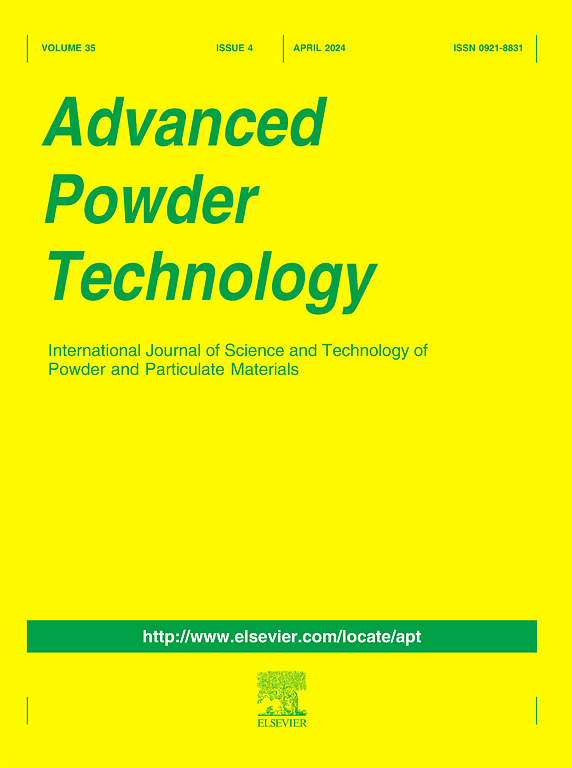Insights into the phase transition behavior of thermochromic VO2 (M1) powders doped with Tungsten
IF 4.2
2区 工程技术
Q2 ENGINEERING, CHEMICAL
引用次数: 0
Abstract
Tungsten (W) is one of the most effective elements in regulating the metal–insulator transition (MIT) temperature of VO2(M1). W-doped VO2 thus shows broader application prospects. However, some issues related to phase transitions affected by W doping remain unclear. Here, the phase transition temperature of VO2 is tuned between −34.8 and 66.0 °C by changing the W concentration, spanning approximately 100 °C. Gaussian fitting for the (011) peak of VO2(M1) reveals its structure transition from the monoclinic phase to the tetragonal phase in W-doped VO2 powder. Lattice distortion is demonstrated to be the primary cause of the reduced critical transition temperature (Tc) because of a slower Tc decrease in mixed-phase VO2. In addition, W-doped VO2 powder exhibits doping-level dependent structure instability, leading to a further reduction in Tc, e.g., a 5 °C decrease for W1.5. Subsequent thermal cycling indicates that the Tc stabilizes after three cycles. These W-doped VO2 powders are used to prepare thermochromic films, where 1.0 at.% W-doped VO2 films show optimal thermochromic performance with a Tc closer to room temperature, making it more ideal for smart windows compared to the undoped film. This work will offer valuable theoretical insights and data references for the future doping engineering design and practical applications of VO2.

掺杂钨的热致变色VO2 (M1)粉末相变行为的研究
钨(W)是调节VO2(M1)金属-绝缘子转变(MIT)温度的最有效元素之一。因此,w掺杂VO2具有更广阔的应用前景。然而,W掺杂对相变影响的一些问题仍不清楚。在这里,通过改变W的浓度,VO2的相变温度在- 34.8 ~ 66.0℃之间,跨度约为100℃。对掺w的VO2(M1)的(011)峰进行高斯拟合,揭示了其结构由单斜相向四方相转变。晶格畸变被证明是临界转变温度(Tc)降低的主要原因,因为混合相VO2的Tc降低较慢。此外,w掺杂的VO2粉末表现出掺杂水平相关的结构不稳定性,导致Tc进一步降低,例如W1.5降低了5°C。随后的热循环表明,Tc在三次循环后趋于稳定。这些w掺杂的VO2粉末用于制备热致变色薄膜,其中1.0 at。掺w的VO2薄膜在Tc接近室温时表现出最佳的热致变色性能,使其比未掺杂的薄膜更理想地用于智能窗户。该工作将为未来VO2掺杂工程设计和实际应用提供有价值的理论见解和数据参考。
本文章由计算机程序翻译,如有差异,请以英文原文为准。
求助全文
约1分钟内获得全文
求助全文
来源期刊

Advanced Powder Technology
工程技术-工程:化工
CiteScore
9.50
自引率
7.70%
发文量
424
审稿时长
55 days
期刊介绍:
The aim of Advanced Powder Technology is to meet the demand for an international journal that integrates all aspects of science and technology research on powder and particulate materials. The journal fulfills this purpose by publishing original research papers, rapid communications, reviews, and translated articles by prominent researchers worldwide.
The editorial work of Advanced Powder Technology, which was founded as the International Journal of the Society of Powder Technology, Japan, is now shared by distinguished board members, who operate in a unique framework designed to respond to the increasing global demand for articles on not only powder and particles, but also on various materials produced from them.
Advanced Powder Technology covers various areas, but a discussion of powder and particles is required in articles. Topics include: Production of powder and particulate materials in gases and liquids(nanoparticles, fine ceramics, pharmaceuticals, novel functional materials, etc.); Aerosol and colloidal processing; Powder and particle characterization; Dynamics and phenomena; Calculation and simulation (CFD, DEM, Monte Carlo method, population balance, etc.); Measurement and control of powder processes; Particle modification; Comminution; Powder handling and operations (storage, transport, granulation, separation, fluidization, etc.)
 求助内容:
求助内容: 应助结果提醒方式:
应助结果提醒方式:


